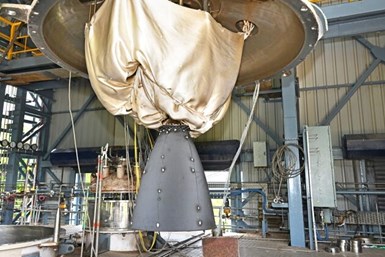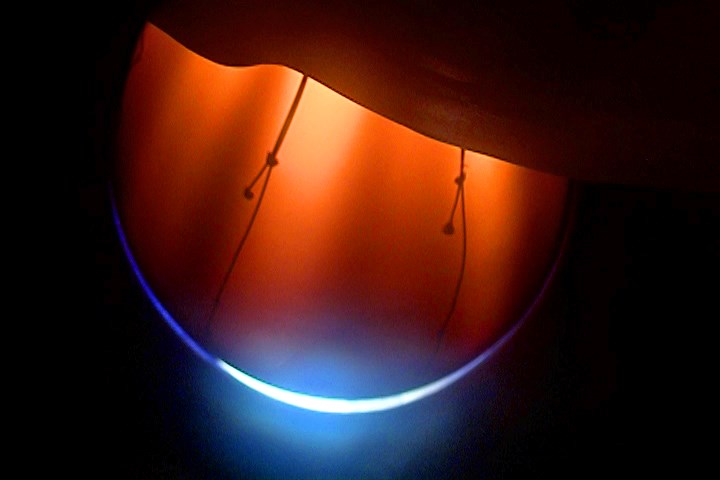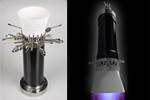ISRO C/C composite nozzle development enhances rocket engines
Durable composite nozzle can replace metal versions for mass reduction and payload capacity boost in launch vehicles.
Share

C/C composite nozzle atached to PS4 engine. Source (All Images) | ISRO
The Indian Space Research Organization (ISRO, Bengaluru, India) has recently developed a lightweight carbon-carbon (C-C) nozzle for rocket engines. This accomplishment by Vikram Sarabhai Space Centre (VSSC) promises to enhance the vital parameters of rocket engines, including thrust levels, specific impulse and thrust-to-weight ratios, thereby boosting the payload capacity of launch vehicles.
VSSC, known for its space research, has leveraged advanced materials like C-C composites (see sidebar) to create a nozzle divergent that offers optimal properties. By using processes such as the carbonization of green composites, chemical vapor infiltration and high-temperature treatment, the resulting nozzle features low density, high specific strength and high stiffness, capable of retaining mechanical properties even at elevated temperatures.
A key feature of the C-C nozzle is its silicon carbide anti-oxidation coating, which extends its operational limits in oxidizing environments. This not only reduces thermally induced stresses but also enhances corrosion resistance, enabling extended operational temperature limits in hostile environments.
The nozzle’s development is significant, particularly for the ISRO’s workhorse launcher, the Polar Satellite Launch Vehicle (PSLV). The PS4, the fourth stage of the PSLV, currently employs twin engines with nozzles made from Columbium alloy. However, by replacing these metallic divergent nozzles with C-C counterparts, a mass reduction of approximately 67% can be achieved. This substitution is projected to increase the payload capability of the PSLV by 15 kilograms.

PS4 engine nozzle divergent development hot test was successfully conducted for a duration of 200 seconds at LUS-TF IPRC in February 2024.
The C-C nozzle divergent have been tested, a collaborative effort involving Liquid Propulsion Systems Centre (LPSC) which designed and configured the test, and IPRC which conducted the test’s instrumentation and execution. In March 2024, a 60-second hot test was conducted at the High-Altitude Test (HAT) facility in ISRO Propulsion Complex (IPRC) in Mahendragiri, confirming the system's performance and hardware integrity. Subsequent tests, including a 200-second hot test in April, further validated the nozzle's capabilities, with temperatures reaching 1216 Kelvin, matching predictions.
Related Content
-
A new era for ceramic matrix composites
CMC is expanding, with new fiber production in Europe, faster processes and higher temperature materials enabling applications for industry, hypersonics and New Space.
-
Cryo-compressed hydrogen, the best solution for storage and refueling stations?
Cryomotive’s CRYOGAS solution claims the highest storage density, lowest refueling cost and widest operating range without H2 losses while using one-fifth the carbon fiber required in compressed gas tanks.
-
Novel dry tape for liquid molded composites
MTorres seeks to enable next-gen aircraft and open new markets for composites with low-cost, high-permeability tapes and versatile, high-speed production lines.
















